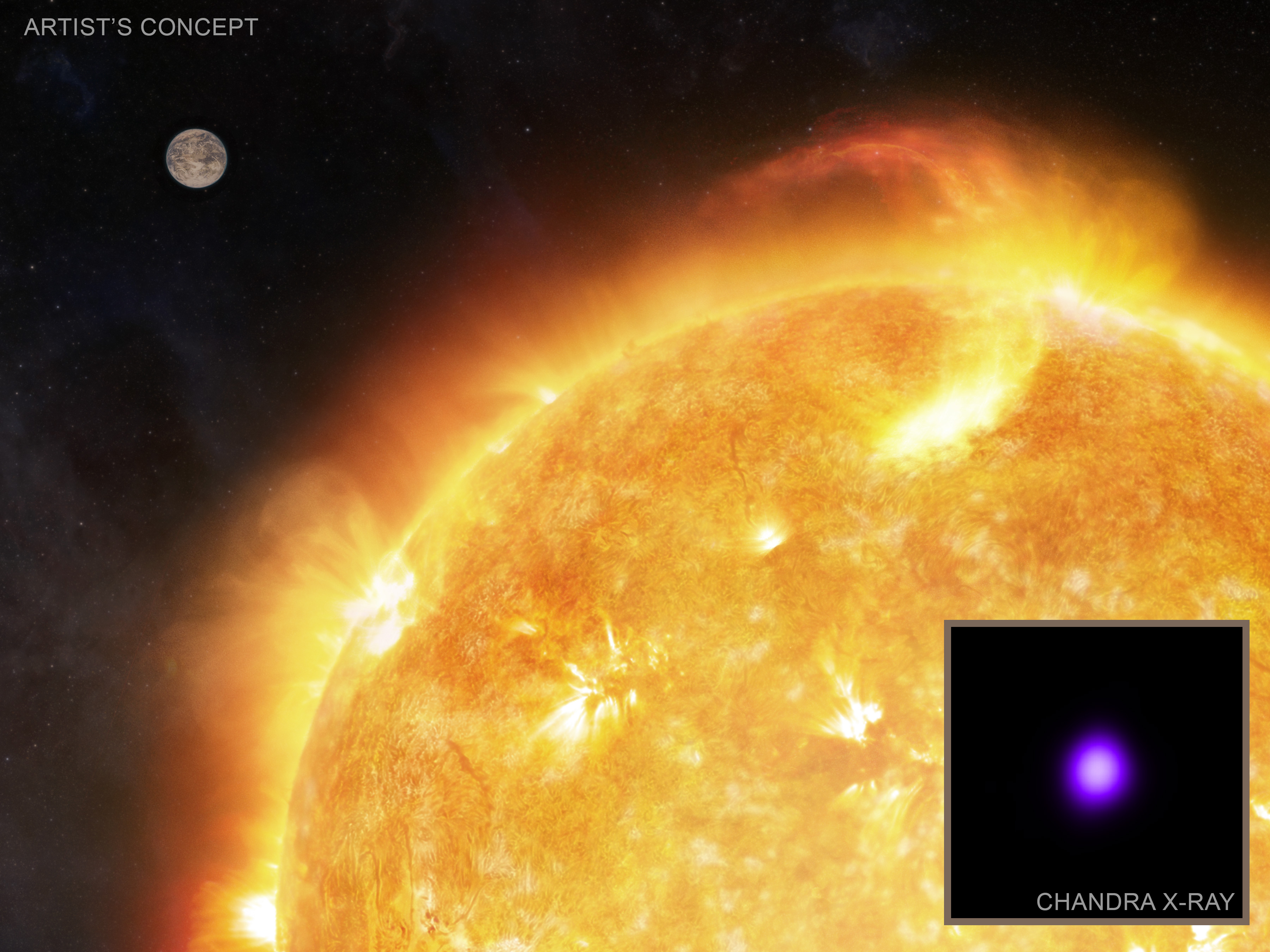Universe Glossary A-G
Contents
- absorption
- absorption line
- accretion
- accretion disk
- active galactic nucleus/nuclei (AGN)
- afterglow
- angstrom (Å)
- angular momentum
- annihilation
- anticoincidence detector
- antimatter
- apoapsis [ap-oh-AP-sis]
- arcminute
- arcsecond
- astronomical unit (au or AU)
- astronomy
- astrophysics
- atmosphere
- Atmospheric Cherenkov Telescope (ACT)
- atom
- Balmer series
- baryon [BARRY-on]
- baryonic acoustic oscillations (BAO)
- Be [bee-ee] star
- big bang
- binary stars
- biosignature
- blackbody radiation
- blackbody temperature
- black dwarf
- black hole
- blazar [BLEY-zar]
- blueshift
- bolometric luminosity
- Boltzmann constant (k)
- bremsstrahlung [BREM-shtrah-luhng]
- brown dwarf
- calibration
- calorimeter
- cataclysmic variable
- Cepheid [SEE-fee-id] variable
- Chandrasekhar limit
- cluster of galaxies
- collecting area
- comet
- Compton scattering
- corona (plural: coronae)
- cosmic dust
- cosmic microwave background (CMB)
- cosmic rays
- cosmological constant (Λ)
- cosmological distance
- cosmological redshift
- cosmology
- dark energy
- dark matter
- de Broglie wavelength
- declination
- degree
- density
- dewar [doo-ur]
- diffuse galactic emission
- disk
- Doppler effect
- eccentricity (e)
- eclipse
- ecliptic
- Eddington limit
- ejecta
- electromagnetic radiation (waves)
- electromagnetic spectrum
- electron
- electron volt (eV)
- element
- ellipse
- emission
- emission line spectrum
- erg/sec
- European Space Agency (ESA)
- event horizon
- exoplanet
- extragalactic
- Fermi acceleration
- fluorescence
- flux
- frequency
- fusion
- galactic halo
- galaxy
- gamma ray
- gamma-ray burst (GRB)
- gas
- general relativity
- giant molecular cloud (GMC)
- globular cluster
- gravitational collapse
- gravitational lensing
- gravitationally bound
- gravitational waves
- gravity
absorption
The process in which atoms or molecules retain the energy delivered by electromagnetic radiation that strikes them. When an atom absorbs light, its electrons are excited into higher energy states.
absorption line
A line of reduced brightness that appears in a continuous spectrum. Absorption lines appear when cooler material, such as a cloud of interstellar gas, lies between a source and the observer.
accretion
Growth by the gradual accumulation of additional matter. For example, young planets grow bigger by accreting gas and dust.
accretion disk
A relatively flat cloud of gas or dust surrounding any massive object growing in size by attracting matter, such as a newborn star or a black hole.
active galactic nucleus/nuclei (AGN)
A class of galaxies whose central regions appear much brighter than ordinary galaxies and are also strong sources of X-ray, ultraviolet, and other radiation. Astronomers think supermassive black holes at the centers of AGN produce this additional energy as they accrete matter. Seyfert galaxies, radio galaxies, quasars, and blazars are all AGN.
afterglow
Lower-energy electromagnetic radiation, including X-rays, visible light, and radio waves, that often follow the initial burst of gamma rays in a gamma-ray burst. Afterglows can persist for days to weeks, gradually dissipating with time. The BeppoSAX satellite discovered the afterglow phenomenon in 1997.
angstrom (Å)
A metric unit of length equal to 0.1 nanometer used to specify wavelengths of electromagnetic radiation, named for Swedish physicist Anders Jonas Ångström (1814–1874).
angular momentum
A property of a mass or system of masses turning about some fixed point, for example, a planet in orbit around a star. It is defined as the body’s mass multiplied by its velocity and its distance from the center of motion. In a closed system, it is a conserved quantity in physics, which means it remains constant. For example, a planet in an eccentric orbit constantly changes the distance from its star. Because the planet’s mass is constant, its velocity must change too — faster at perihelion, slower at aphelion — so that its angular momentum remains the same at every point in the orbit. The conservation of angular momentum explains Kepler’s second law of planetary motion.
annihilation
The mutual conversion of a particle and its antiparticle into electromagnetic radiation, converting their mass (m) into energy (E) according to Einstein’s famous formula, E = mc2, where c is the speed of light. An electron and a positron annihilate to produce two gamma-ray photons, each with an energy of 511 keV.
anticoincidence detector
A system on a gamma-ray observatory that triggers when it detects a charged particle entering the telescope so a detector does not mistake the incoming particle for a gamma ray.
antimatter
Counterparts of the subatomic particles making up normal matter that have opposite properties, typically electrical charge (the antineutron has reversed magnetic polarity, and antineutrinos have reversed spin). When a particle and its antiparticle collide, they annihilate. The positron is the antiparticle of the electron. By manipulating positrons into orbit around antiprotons, scientists at the European Organization for Nuclear Research (CERN) created the first antimatter atoms — antihydrogen — in 1995.
apoapsis [ap-oh-AP-sis]
The farthest point in the path of an orbiting body; its opposite is periapsis. This relationship takes on special names in commonly used systems:
- apastron, of a body orbiting a star
- apogee, of a body orbiting Earth
- apojove, of a body orbiting Jupiter
- aphelion, of a body orbiting the Sun. Earth reaches aphelion around July 5 each year.
- apolune, of a body orbiting the Moon
arcminute
An angular measurement equal to 1/60th of a degree. It is approximately the smallest angle discernible to the unaided human eye. As viewed from Earth, both the Sun and the Moon appear about 30 arcminutes across.
arcsecond
An angular measurement equal to 1/3,600th of a degree or 1/60th of an arcminute. This is about the apparent thickness of a U.S. dime viewed from a distance of about 278 meters (913 feet).
astronomical unit (au or AU)
A unit of length approximating the distance from Earth to the Sun, defined as 149,597,870.7 km (92,955,807.3 miles).
astronomy
The scientific study of matter in outer space, especially the positions, dimensions, distribution, motion, composition, energy, and evolution of celestial bodies and phenomena.
astrophysics
The branch of astronomy concerned with the physical nature of stars, galaxies, interstellar clouds, and other objects, including their luminosities, temperatures, densities, and chemical composition.
atmosphere
The envelope of gas that surrounds a planet or star.
Atmospheric Cherenkov Telescope (ACT)
A ground-based telescope that observes high-energy gamma rays and cosmic rays through the faint flashes of blue light they produce when interacting with Earth’s atmosphere. High-energy radiation entering the atmosphere eventually collides with molecules in the air. Each impact shatters the molecule’s atoms into their constituent particles — protons, neutrons, electrons — and produces others, such as muons and pions. These particles then strike other atoms, producing more fast-moving debris that breaks apart more atoms, and so on. This cascade of particles moves faster through air than light is able to, which results in a broad blue flash called Cherenkov light, named for the Russian physicist Pavel Cherenkov (1904–1990).
atom
The smallest unit of an element that retains the element’s characteristics. An atom consists of a central nucleus with one or more protons and neutrons (except for hydrogen, which may have no neutrons) orbited by one or more electrons. Each chemical element consists of atoms that possess a characteristic number of protons (e.g., one for hydrogen, eight for oxygen) reflected in its atomic number. By sharing their electrons, atoms join together to form larger structures called molecules.
Balmer series
A set of emission or absorption lines in the spectrum of hydrogen that arise from electron transitions between the atom’s first excited state and those at higher energies, discovered by the Swiss physicist Johann Balmer (1825–1898). The first four lines prominent in visible light are identified using the chemical symbol for hydrogen (H) and the lowercase Greek letters alpha (α), beta (β), gamma (γ), and delta (δ). Because hydrogen is the universe’s most abundant element, the Balmer lines play a major role in how we see the cosmos. For example, the light of the Hα line provides the prominent reddish color to images of emission nebulae taken in natural light. Hydrogen also produces additional line sets beyond visible light, including the Lyman series (ultraviolet, important for cosmology), the Paschen series (infrared) and the Brackett series (far infrared).
baryon [BARRY-on]
A class of hadrons built from three quarks that includes protons and neutrons. The other class, called mesons, are unstable particles built from only two quarks. Baryons produce both electromagnetic and gravitational signals that reveal their presence throughout the universe. In astronomy, the term “baryonic matter” refers more loosely to the normal atomic matter (including electrons) that makes up people, planets, stars, and galaxies. It represents just 4.9% of the mass-energy in the universe. See also: dark matter and dark energy.
baryonic acoustic oscillations (BAO)
Sound waves from the early universe whose imprint is reflected in the large-scale distribution of matter. When the universe was a hot, dense plasma, regions with greater concentrations of light and matter were at higher pressure, and sound waves rippled outward from them. These waves carried along ordinary (baryonic) matter until the universe cooled enough that light could travel freely, which is when the cosmic microwave background formed. The movement of matter from sound waves up to this time resulted in spherical shells of excess density throughout the cosmos, and they grew in size as the universe expanded. BAOs appear in the temperature variations of the cosmic microwave background, and today they leave a faint imprint in the clustering of galaxies — detectable as a small excess in the number of galaxy pairs separated by about 500 million light-years. These features serve as “standard rulers” that allow astronomers to probe the expansion rate of the universe and learn more about dark energy.
Be [bee-ee] star
A hot, often variable star of spectral class B that shows emission lines (the “e” in the name) in its spectrum. Be stars rotate so rapidly that they eject material, which collects into a surrounding disk thought to be many times the star’s size. Hydrogen emission lines arise because the star’s ultraviolet light interacts with the gaseous disk. Examples include Gamma Cassiopeiae A — the first one identified, in 1866 — and the bright southern star Achernar (Alpha Eridani A).
big bang
A widely accepted model of the universe that explains its observed properties by postulating that it originated as a tiny, superdense, rapidly expanding fireball about 13.8 billion years ago. The universe expanded, cooled, and condensed into subatomic particles that later accumulated into the matter that formed stars and galaxies. The model naturally explains the cosmic microwave background, the expansion of space, and the ratio of hydrogen, helium, and other light elements observed throughout the universe.
binary stars
Two stars that are gravitationally bound together and orbit their common center of mass.
biosignature
An indicator that provides scientific evidence for the presence of past or present life. In exoplanet research, scientists have suggested that certain gases — such as oxygen, ozone, methane, nitrous oxide, methyl bromide, methyl chloride, hydrogen sulfide, carbonyl sulfide, phosphine, sulfur dioxide, and others — could accumulate in the atmosphere of an exoplanet as byproducts of life. Detecting spectral lines from such gases could, in principle, allow astronomers to determine the presence of life on these worlds.
blackbody radiation
Radiation emitted by a model object that emits all electromagnetic radiation perfectly. This means that the pattern of the intensity of radiation emitted over a range of wavelengths (i.e., its spectral energy distribution) depends only on the blackbody’s temperature. For a blackbody at a temperature (T), the intensity (I) of radiation emitted at a particular energy (E) is given by Planck’s law:I(E,T) = 2 E3[h2c2(eE/kT – 1)]-1where h is Planck’s constant, k is Boltzmann’s constant, and c is the speed of light.
blackbody temperature
The temperature of a body, such as a star or planet, equal to that of a perfect radiator (a blackbody) that would emit the same total amount of electromagnetic radiation. Other names for the same essential concept are effective temperature and equilibrium temperature. The body’s actual temperature may be quite different depending on additional properties, such as the presence of a heat-retaining atmosphere around a planet. An extreme example is Venus, which has a blackbody temperature of 227 K (–46° C or 51° F) but a globally averaged surface temperature of 737 K (464° C or 867° F).
black dwarf
A hypothetical stellar remnant formed once a white dwarf has radiated away all of its energy and no longer emits heat or light. The time required to reach this state is expected to be hundreds of billions of years. Because this is far longer than the age of the oldest white dwarf in our universe, they do not yet exist.
black hole
An object whose gravity is so strong that not even light can escape from it. Black holes are completely characterized by only three parameters: mass, rotation, and electrical charge. Abundant observational evidence exists for stellar-mass black holes, with masses from four to dozens of solar masses formed through the collapse of massive stars at the ends of their lives, with the higher-mass objects formed through mergers. Supermassive black holes weighing hundreds of thousands to billions of solar masses are observed at the centers of most large galaxies and power AGNs. Although expected to exist, there is less certain evidence for intermediate-mass black holes of hundreds to one hundred thousand solar masses. Primordial black holes are hypothetical objects that may have formed in the early universe; they represent a possible explanation for dark matter.
blazar [BLEY-zar]
A type of active galactic nucleus often appearing as a bright, highly variable point-like source that does not display emission lines. Blazars vary dramatically in all observable parts of the electromagnetic spectrum, so studying them requires simultaneous multiwavelength observations. An accreting supermassive black hole at the center of a blazar expels jets of matter in opposite directions that travel at nearly the speed of light. Blazars appear so bright and variable because we are looking almost directly down the barrel of one jet.
blueshift
An apparent shift toward shorter wavelengths of spectral lines emitted by an object caused by its motion toward an observer. See also: Doppler effect and redshift.
bolometric luminosity
The total energy radiated by an object at all wavelengths, usually given in watts. For example, the Sun’s bolometric luminosity is 3.83 x 1026 watts. See also: scientific notation.
Boltzmann constant (k)
A number that relates the temperature of an ideal gas to the average kinetic energy of molecules in the gas. It is defined as 1.380649 x 10–23 joule per kelvin. Named for Austrian physicist Ludwig Boltzmann (1844–1906).
bremsstrahlung [BREM-shtrah-luhng]
Electromagnetic radiation emitted when a charged particle, such as an electron, decelerates when deflected by the electric and magnetic fields of another particle or atomic nucleus. Very fast charged particles primarily lose energy by this process when traveling through matter. The term is a German word that literally means “braking radiation.”
brown dwarf
Substellar objects lacking the mass needed to begin the hydrogen fusion processes found in the cores of full-fledged stars.
calibration
A process for translating the signals produced by a measuring instrument (such as a detector attached to a telescope) into something that is scientifically useful. This procedure removes most of the errors caused by environmental and instrumental instabilities.
calorimeter
An instrument that measures the energy of a particle or photon through the amount of heat the particle or photon deposits in a material.
cataclysmic variable
A close binary star system where a white dwarf accretes gas from a low-mass normal star. The gas collects into an accretion disk around the white dwarf and then flows onto its surface, producing X-rays. In some systems, this gas accumulates and eventually begins thermonuclear fusion reactions, producing a nova outburst that suddenly increases the system’s apparent brightness by up to 100,000 times.
Cepheid [SEE-fee-id] variable
A type of star that regularly expands and contracts, resulting in a repeating cycle of brightness changes over time. The length of the pulsation cycle is directly related to the star’s intrinsic brightness, and astronomers can determine its distance by comparing this to the star’s observed brightness. This discovery, made in 1912 by Henrietta Leavitt (1868–1921), transforms cepheid variables into a powerful astronomical tool. The class is named for its prototype, Delta Cephei, and includes Polaris, the closest member to the Sun. Both are Type I cepheids, with pulsation periods ranging from 1.5 to more than 50 days. Type II cepheids include two subclasses, with BL Herculis stars exhibiting periods of a few days and W Virginis stars showing periods greater than about 10 days.
Chandrasekhar limit
The theoretical maximum mass of a white dwarf, equal to about 1.4 solar masses. Beyond it, a white dwarf must collapse into a neutron star. Named for Subrahmanyan Chandrasekhar (1910–1995), who calculated it in 1931.
cluster of galaxies
A system of galaxies containing anywhere between a few and a few thousand member galaxies that are gravitationally bound together. Also called a galaxy cluster.
collecting area
The area of a telescope that is capable of collecting light. Collecting area is important for a telescope’s sensitivity: the more radiation it can collect (that is, the larger its collecting area), the better it can detect dimmer objects.
comet
A small ice-rich body, typically less than about 20 km (12 miles) across, that travels around the Sun, often in highly eccentric orbits. The solid body is also called the comet’s nucleus. It is composed of frozen gases — including water ice, carbon dioxide, carbon monoxide, methane, and ammonia — mixed with dust and organic molecules. When a comet nears the Sun, it warms up, and ice on the surface converts to gas, forming jets that carry ice and dust grains into space. This material surrounds the comet with a vast atmosphere, called a coma, typically up to 80,000 km (50,000 miles) across. Ultraviolet sunlight breaks up water molecules released by the comet, and this forms a vast, thin neutral hydrogen cloud visible only in UV light that may span 100 million km (62 million miles). Radiation pressure from sunlight pushes dust grains averaging a micrometer across — about the size of particles in smoke — out of the coma. They sweep back into a gently curved dust tail that glows by reflecting sunlight and may extend tens of millions of kilometers; it is the most visually striking phenomenon associated with comets. Additionally, the solar wind acts on charged ions broken off of molecules by UV sunlight, sweeping them into a straight, narrow, bluish, and visually faint gas tail (also called an ion or plasma tail) that shines by fluorescence. In 1996, the joint ESA-NASA Ulysses mission unexpectedly passed through the gas tail of comet Hyakutake (C/1996 B2) from a distance of 570 million km (360 million miles), making it the longest comet tail known. Hyakutake is also the first comet shown to emit X-rays.
Compton scattering
A transfer of energy between a photon and a particle, such as an electron, that lowers the photon’s energy and increases the velocity of the particle. Inverse Compton scattering occurs when a charged particle transfers some of its energy to a photon, boosting it to higher energy, and plays an important role in astrophysics. When light from microwave to ultraviolet wavelengths collides with a high-energy particle, the interaction can boost the photon to gamma-ray energies.
corona (plural: coronae)
The outermost level of a star’s atmosphere. In the Sun, the corona is characterized by low densities and high temperatures (exceeding 1 million Celsius or 1.8 million Fahrenheit).
cosmic dust
Irregularly shaped grains of carbon and/or silicates measuring a fraction of a micron across which are found between the stars. Dust is most evident by its absorption, causing large dark patches in regions of our Milky Way galaxy and dark bands across other galaxies.
cosmic microwave background (CMB)
A faint signal present everywhere in the sky and the oldest light we can detect, discovered in 1965 by American astronomers Arno Penzias and Robert Wilson. It is the afterglow of the hot, young, expanding universe at a time when it was only about 380,000 years old, a fraction of its current age of 13.8 billion years. Before this time, the universe was a hot, dense plasma filled with electrons, protons, nuclei, neutrinos, other particles, and light. All light was tied up with interactions between particles, especially electrons, so it couldn’t travel far before striking one of them, making the universe an opaque fog. As it expanded and cooled below about 3,000 K, electrons, protons and nuclei could combine into atoms. This greatly reduced the number of free electrons that light could crash into, and for the first time the universe became transparent — light could travel unimpeded through the cosmos. The continued expansion of space has redshifted the wavelength of this glow by about 1,100 times, so we detect the CMB in the microwave part of the electromagnetic spectrum, brightest at a wavelength of 1.9 mm (corresponding to near-ultraviolet light when it last bounced off an electron). The CMB exhibits a perfect blackbody spectrum with an average temperature of about 2.725 K and shows very small temperature differences, measured in microkelvins, that were first detected by NASA’s COBE satellite and mapped in greater detail by the WMAP and Planck missions. These variations reflect differences in the density of the universe that were already present before the CMB formed and that ultimately led to the formation of the first stars and galaxies.
cosmic rays
Atomic nuclei — about 90% of them protons — and elementary particles, such as electrons, that travel through interstellar space at speeds approaching that of light.
cosmological constant (Λ)
A mathematical fix to the general theory of relativity, symbolized by the capital Greek letter lambda (Λ), which Einstein proposed in the mistaken belief that the universe was static, neither expanding nor contracting. By 1929 observations made clear that the universe is expanding, and so this fix was unnecessary. If Einstein had believed what his equations were telling him, he could have claimed the expansion of the universe as perhaps the greatest and most convincing prediction of general relativity — a failure he called the “greatest blunder of my life.” See also: dark energy.
cosmological distance
A distance far beyond the boundaries of our galaxy. When viewing objects at cosmological distances, the curved nature of space-time introduces effects such as time dilation and cosmological redshift.
cosmological redshift
An effect where light emitted from a distant source appears redshifted because of the expansion of space-time. See also: Doppler effect.
cosmology
The branch of astrophysics concerned with the history, structure, dynamics, and evolution of universe.
dark energy
A theoretical repulsive pressure that behaves the opposite of gravity and drives the ever-accelerating expansion of space. In 1998, astronomers George Smoot, Brian Schmidt, and Adam Reiss unexpectedly discovered, through studies of distant supernovae, that the expansion of space was speeding up over time. While the nature of dark energy is unknown, cosmologists have determined that it makes up 68.3% of the mass-energy in the universe. One possible explanation for dark energy involves properties of space similar to those suggested by Einstein for his cosmological constant.
dark matter
Hypothetical non-baryonic matter of unknown composition that does not emit or reflect enough electromagnetic radiation to be observed directly, but whose presence can be inferred from gravitational effects on visible matter. Observations of the motions of stars and gas in galaxies, the properties of hot gas in galaxy clusters and the radial velocities of their member galaxies, and gravitational lensing of distant background galaxies by foreground galaxy clusters indicate the presence of large amounts of dark matter. It is now thought to comprise 26.8% of the total mass-energy in the universe. Candidate particles include WIMPs, axions, and even primordial black holes. See also: baryonic matter and dark energy.
de Broglie wavelength
The quantum mechanical wavelength associated with a particle, named after Louis de Broglie (1892–1987), who in 1924 proposed the concept that matter behaves like a wave. In quantum mechanics, all massive particles have wave characteristics, where the wavelength of a particle equals the Planck constant divided by the particle’s momentum.
declination
A celestial coordinate which, along with right ascension, locates any position in the sky. Analogous to latitude on Earth, it extends from +90 degrees to –90 degrees.
degree
An angular measure devised so there are 360 degrees in a circle. From Earth, the Sun and Moon both appear to be about 0.5 degree across. The term is also used to describe a unit of temperature in the Celsius and Fahrenheit scales.
density
The ratio between the mass of an object and its volume. In the metric system, density is measured in grams per cubic centimeter (or kilograms per liter); the density of water is 1.0 gm/cm3; iron is 7.9 gm/cm3; lead is 11.3 gm/cm3.
dewar [doo-ur]
A double-walled container of metal or silvered glass with a vacuum between the walls, used to hold low-temperature liquids. In astronomy, dewars are often used for liquid nitrogen (temperature, 77 K), but can also be used for liquid helium (4.2 K) or solid neon (17 K). These materials are used because astronomical detectors work better at such cold temperatures. The dewar was invented by Sir James Dewar (1842–1923), a Scottish chemist and physicist.
diffuse galactic emission
Widespread gamma-ray emission along the plane of our Milky Way galaxy. It arises mostly from cosmic rays interacting with interstellar gas, dust, and starlight.
disk
(a) A flattened, circular region of gas, dust, and/or stars. It may refer to material surrounding a newly-formed star; material accreting onto a black hole or neutron star; or the large region of a spiral galaxy containing the spiral arms. (b) The apparent circular shape of the Sun, a planet, or the Moon when seen in the sky or through a telescope.
Doppler effect
The apparent change in wavelength of sound or light caused by the motion of the source, observer, or both. Waves emitted by a moving object as received by an observer will be blueshifted (compressed) if approaching, redshifted (elongated) if receding. It occurs both in sound and light. How much the frequency changes depends on how fast the object is moving toward or away from the receiver. See also: cosmological redshift.
eccentricity (e)
The amount by which an elliptical orbit deviates from a perfect circle, which has an eccentricity of 0. Elliptical orbits have values between 0 and 1, parabolic orbits have a value of exactly 1, and hyperbolic orbits have values exceeding 1. Eccentricity is the ratio of the distance between the focus points and the major axis of the ellipse. Equivalently, the eccentricity is (ra– rp) / (ra+rp), where ra is the apoapsis distance and rp is the periapsis distance.
eclipse
The passage of one celestial body in front of another, cutting off the light from the second body (for example, an eclipse of the Sun by the Moon, or of one star in a binary system eclipsing the other). It may also refer to the passage of all or part of one body through the shadow of another (for example, in a lunar eclipse, the Moon passes through Earth’s shadow).
ecliptic
The plane of Earth’s orbit about the Sun. The Sun follows the ecliptic in its apparent annual motion through the sky.
Eddington limit
The theoretical maximum luminosity a body, such as a star, can attain when the outward force of its radiation balances the inward force of its gravitational pull. A body exceeding this luminosity will emit an intense outflow (called a stellar wind) from its outer layers. Supernovae, novae, gamma-ray bursts, and accreting black holes in active galaxies can briefly exceed their Eddington luminosities, producing short, intense outflows. Named for English astronomer and physicist Sir Arthur Stanley Eddington (1882-1944).
ejecta
Material that is ejected. Used mostly to describe the content of a massive star that is propelled outward in a supernova explosion. Also used to describe the material that is blown radially outward in a meteor impact on the surface of a planet or Moon.
electromagnetic radiation (waves)
Light in all of its forms, including radio, infrared, visible light, ultraviolet, X-rays, and gamma rays. Electromagnetic radiation moves at the speed of light and is a traveling periodic fluctuation of an electric and magnetic field. These fields oscillate at right angles to each other and to the wave’s travel direction.
electromagnetic spectrum
The full range of frequencies, from radio waves to gamma rays, that characterizes electromagnetic radiation (light).
electron
A negatively charged particle commonly found in the outer layers of atoms. The electron has only 0.0005 the mass of the proton.
electron volt (eV)
The change of potential energy experienced by an electron moving from a place where the potential has a value of V to a place where it has a value of V+1 volt. This is a convenient energy unit when dealing with the motions of electrons and ions in electric fields; the unit is also the one used to describe the energy of X-rays and gamma rays. A keV (or kiloelectron volt) is equal to 1,000 electron volts. An MeV is equal to one million electron volts. A GeV is equal to one billion (109) electron volts. A TeV is equal to a million million (1012) electron volts.
element
A substance made from atoms that have the same number of protons in their nuclei (their atomic number). Elements cannot be chemically interconverted or broken down into simpler substances and are primary constituents of matter; there are 118 elements known. Hydrogen and helium are the simplest and most abundant elements in the universe, making up about 74% and 24% of all the matter, respectively. Heavier elements — often collectively called “metals” in astronomy — comprise about 2% of the Milky Way’s disk but can greatly influence astronomical phenomena.
ellipse
A curve on a plane surrounding two focal points, such that the sum of the distances from both of these points is constant for all points on the curve. A circle is a special type of ellipse where both focal points are located in the same spot. The orbits of the planets are non-circular ellipses, a fact first recognized by Johannes Kepler (1571–1630) through analysis of careful observations of Mars collected by the Danish astronomer Tycho Brahe (1546–1601).
emission
The production of light, or more generally, electromagnetic radiation by an atom or other object.
emission line spectrum
A spectrum consisting of bright lines at certain wavelengths separated by dark regions in which there is no light.
erg/sec
A form of the metric unit for power. It is equal to 10–10 kilowatts. See also: scientific notation.
European Space Agency (ESA)
An intergovernmental organization of 22 European states dedicated to the exploration of space, established in 1975, and headquartered in Paris. ESA maintains and operates the Guiana Space Centre, a major spaceport near Kourou, French Guiana.
event horizon
The distance from a black hole where the escape velocity equals the speed of light, the fastest possible speed known, and within which nothing can escape. In this sense, the event horizon is a “point of no return.” See also: Schwarzschild radius.
exoplanet
A planet beyond our solar system.
extragalactic
Beyond our own galaxy, the Milky Way.
Fermi acceleration
A process by which charged particles gain energy through repeatedly passing through magnetic fields, typically those associated with the shock waves produced by solar flares or supernova explosions. This process produces high-energy cosmic rays, which travel close to the speed of light.
fluorescence
The emission of light by a substance that has absorbed light or other electromagnetic radiation. Typically, the emitted light has a longer wavelength, and therefore lower energy, than the absorbed radiation. Ions of carbon monoxide (CO) in the gas tails of comets absorb ultraviolet sunlight, then emit bluish light at a wavelength of 420 nm.
flux
A measure of the amount of energy given off by an astronomical object over a fixed amount of time and area. Flux measurements make it easy for astronomers to compare the relative energy output of objects with very different sizes or ages.
frequency
A property of a wave that describes how many wave patterns or cycles pass by in a period of time. Frequency is often measured in hertz (Hz), where a wave with a frequency of 1 Hz will go through 1 cycle each second.
fusion
The process in which atomic nuclei collide so fast that they stick together and emit a large amount of energy. In the centers of most stars, hydrogen fuses into helium. The energy emitted by fusion supports the star’s enormous mass from collapsing in on itself and causes the star to glow.
galactic halo
A spherical region surrounding a galaxy that may extend beyond its visible boundaries and contain a significant fraction of the galaxy’s mass.
galaxy
A component of our universe made up of gas, dust, and numerous (usually more than a million) stars held together by gravity.
gamma ray
The highest-energy, shortest-wavelength electromagnetic radiation. Usually, thought of as any light having energies greater than about 500 keV.
gamma-ray burst (GRB)
A burst of gamma rays from space lasting from a fraction of a second to many minutes. In general, GRBs longer than 2 seconds are associated with supernovae and are thought to occur when a collapsing massive star forms a black hole, driving high-energy jets that drill through the star and emit gamma rays when they emerge. Shorter bursts are associated with end stage of binary systems containing either a pair of neutron stars or a neutron star and a black hole, which produce similar jets of matter when they merge. – LESS
gas
One of four states of matter, in which atoms, molecules, or ions move freely and are not bound to each other. In astronomy, it usually refers to hydrogen or helium.
general relativity
The geometric theory of gravitation developed by Albert Einstein (1879–1955), which incorporated and extended his theory of special relativity to include accelerated frames of reference and introduced the principle that gravitational and inertial forces are equivalent. The theory has consequences for the bending of light by massive objects, the nature of black holes, and the fabric of space and time. See also: special relativity.– LESS
giant molecular cloud (GMC)
Massive clouds of gas in interstellar space composed primarily of hydrogen molecules (two hydrogen atoms bound together), but also containing other molecules observable by radio telescopes. These clouds can contain enough mass to make several million stars like our Sun and are often the sites of star formation.– LESS
globular cluster
A spherically symmetric collection of stars which share a common origin. The cluster may contain up to millions of stars and span more than 150 light-years.
gravitational collapse
When a massive body collapses under its own weight. For example, interstellar clouds collapse to become stars until the onset of nuclear fusion stops the collapse.
gravitational lensing
A phenomenon where a concentration of matter, such as a star or a cluster of galaxies, distorts and magnifies the light of more distant objects passing through it. Einstein’s general theory of relativity describes how masses distort the space-time around them, and light from more distant objects passing through this region must travel through the distorted space. The effect allows astronomers to detect planets around stars that would otherwise be undetectable (microlensing), and on larger scales allows researchers to study the details of galaxies that would otherwise be too far away to be seen with current telescopes.
gravitationally bound
Objects held in orbit about each other by their gravitational attraction. For example, satellites in orbit around Earth are gravitationally bound to it because they can’t escape Earth’s gravity. By contrast, the Voyager spacecraft were launched with enough energy to escape the Sun’s gravity and hence are not gravitationally bound.
gravitational waves
Ripples in space-time caused by the acceleration of massive objects. The first directly detected sources include binary systems where orbiting black holes or neutron stars merged together. Gravitational waves are also thought to emanate from the motion of matter during the big bang.
gravity
A mutual physical force attracting two bodies.


























